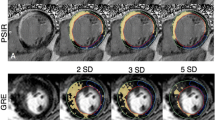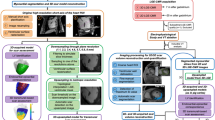Abstract
The quantification and modeling of myocardial scar is of expanding interest for image-guided therapy, particularly in the field of arrhythmia management. Migration towards high-resolution, three-dimensional (3D) MRI techniques for spatial mapping of myocardial scar provides superior spatial registration. However, to date no systematic comparison of available approaches to 3D scar quantification have been performed. In this study we compare the reproducibility of six 3D scar segmentation algorithms for determination of left ventricular scar volume. Additionally, comparison to two-dimensional (2D) scar quantification and 3D manual segmentation is performed. Thirty-five consecutive patients with ischemic cardiomyopathy were recruited and underwent conventional 2D late gadolinium enhancement (LGE) and 3D isotropic LGE imaging (voxel size 1.3 mm3) using a 3 T scanner. 3D LGE datasets were analyzed using six semi-automated segmentation techniques, including the signal threshold versus reference mean (STRM) technique at >2, >3, >5 and >6 standard deviations (SD) above reference myocardium, the full width at half maximum (FWHM) technique, and an optimization-based technique called hierarchical max flow (HMF). The mean ejection fraction was 32.1 ± 12.7 %. Reproducibility was greatest for HMF and FWHM techniques with intra-class correlation coefficient values ≥0.95. 3D scar quantification and modeling is clinically feasible in patients with ischemic cardiomyopathy. While several approaches show acceptable reproducibility, HMF appears superior due to maintenance of accuracy towards manual segmentations.


Similar content being viewed by others
Abbreviations
- LGE:
-
Late gadolinium enhancement
- CMR:
-
Cardiac magnetic resonance
- MF:
-
Myocardial fibrosis
- 2D:
-
Two-dimensional
- 3D:
-
Three-dimensional
- WH:
-
Whole-heart
- SI:
-
Signal intensity
- SAX:
-
Short-axis
- FWHM:
-
Full-width-at-half-maximum
- STRM:
-
Signal-threshold-to-reference-mean
- SD:
-
Standard deviation
- HMF:
-
Hierarchical max-flow
- MVO:
-
Mean voxel overlap
- AVD:
-
Absolute volume difference
- ICC:
-
Intra-class correlation coefficient
References
Stirrat J, White JA (2013) The prognostic role of late gadolinium enhancement magnetic resonance imaging in patients with cardiomyopathy. Can J Cardiol 29(3):329–336
Goetti R, Kozerke S, Donati OF, Sürder D, Stolzmann P, Kaufmann PA, Lüscher TF, Corti R, Manka R (2011) Acute, subacute, and chronic myocardial infarction: quantitative comparison of 2D and 3D late gadolinium enhancement MR imaging. Radiology 259(3):704–711
Kecskemeti S, Johnson K, François CJ, Schiebler ML, Unal O (2013) Volumetric late gadolinium-enhanced myocardial imaging with retrospective inversion time selection. J Magn Reson Imaging 38(5):1276–1282
Keegan J, Jhooti P, Babu-Narayan SV, Drivas P, Ernst S, Firmin DN (2013) Improved respiratory efficiency of 3D late gadolinium enhancement imaging using the continuously adaptive windowing strategy (CLAWS). Magn Reson Med 71(3):1064–1074
White JA, Fine N, Gula LJ, Yee R, Al-Admawi M, Zhang Q, Krahn A, Skanes A, MacDonald A, Peters T, Drangova M (2010) Fused whole-heart coronary and myocardial scar imaging using 3-T CMR. Implications for planning of cardiac resynchronization therapy and coronary revascularization. JACC Cardiovasc Imaging 3(9):921–930
Duckett SG, Chiribiri A, Ginks MR, Sinclair S, Knowles BR, Botnar R, Carr-White GS, Carr-Rinaldi CA, Nagel E, Razavi R, Schaeffter T (2011) Cardiac MRI to investigate myocardial scar and coronary venous anatomy using a slow infusion of dimeglumine gadobenate in patients undergoing assessment for cardiac resynchronization therapy. J Magn Reson Imaging 33(1):87–95
Fernández-Armenta J, Berruezo A, Andreu D, Camara O, Silva E, Serra L, Barbarito V, Carotenutto L, Evertz R, Ortiz-Pérez JT, De Caralt TM, Perea RJ, Sitges M, Mont L, Frangi A, Brugada J (2013) Three-dimensional architecture of scar and conducting channels based on high resolution ce-CMR: insights for ventricular tachycardia ablation. Circ Arrhythm Electrophysiol 6(3):528–537
Sohns C, Karim R, Harrison J, Arujuna A, Linton N, Sennet R, Lambert H, Leo G, Williams S, Razavi R, Wright M, Schaeffter T, O'Neill M, Rhode K (2014) Quantitative magnetic resonance imaging analysis of the relationship between contact force and left atrial scar formation after catheter ablation of atrial fibrillation. J Magn Reson Imaging 25(2):138-145
Adluru G, Chen L, Kim S-E, Burgon N, Kholmovski EG, Marrouche NF, Dibella EVR (2011) Three-dimensional late gadolinium enhancement imaging of the left atrium with a hybrid radial acquisition and compressed sensing. J Magn Reson Imaging 34(6):1465–1471
Vergara GR, Marrouche NF (2011) Tailored management of atrial fibrillation using a LGE-MRI based model: from the clinic to the electrophysiology laboratory. J Cardiovasc Electrophysiol 22(4):481–487
Morita K, Utsunomiya D, Oda S, Komi M, Namimoto T, Hirai T, Hashida M, Takashio S, Yamamuro M, Yamashita Y (2013) Comparison of 3D phase-sensitive inversion-recovery and 2D inversion-recovery MRI at 3.0 T for the assessment of late gadolinium enhancement in patients with hypertrophic cardiomyopathy. Acad Radiol 20(6):752–757
Viallon M, Jacquier A, Rotaru C, Delattre BMA, Mewton N, Vincent F, Croisille P (2011) Head-to-head comparison of eight late gadolinium-enhanced cardiac MR (LGE CMR) sequences at 1.5 tesla: from bench to bedside. J Magn Reson Imaging 34(6):1374–1387
Matsumoto H, Matsuda T, Miyamoto K, Nakatsuma K, Sugahara M, Shimada T (2013) Feasibility of free-breathing late gadolinium-enhanced cardiovascular MRI for assessment of myocardial infarction: navigator-gated versus single-shot imaging. Int J Cardiol 168(1):94–99
Akçakaya M, Rayatzadeh H, Basha TA, Hong SN, Chan RH, Kissinger KV, Hauser TH, Josephson ME, Manning WJ, Nezafat R (2012) Accelerated late gadolinium enhancement cardiac MR imaging with isotropic spatial resolution using compressed sensing: initial experience. Radiology 264:691–699
Flett AS, Hasleton J, Cook C, Hausenloy D, Quarta G, Ariti C, Muthurangu V, Moon JC (2011) Evaluation of techniques for the quantification of myocardial scar of differing etiology using cardiac magnetic resonance. JACC Cardiovasc Imaging 4(2):150–156
Yin G, Zhao S, Lu M, Ma N, Zuehlsdorff S, Cheng H, Jiang S, Zhao T, Zhang Y, An J et al (2012) Assessment of left ventricular myocardial scar in coronary artery disease by a three-dimensional MR imaging technique. J Magn Reson Imaging 38(1):72-79
Kino A, Zuehlsdorff S, Sheehan JJ, Weale PJ, Carroll TJ, Jerecic R, Carr JC (2009) Three-dimensional phase-sensitive inversion-recovery turbo FLASH sequence for the evaluation of left ventricular myocardial scar. Am J Roentgenol 193(5):381–388
Rajchl M, Yuan J, Ukwatta E, Peters TM (2012) Fast interactive multi-region cardiac segmentation with linearly ordered labels. In: 2012 9th IEEE International Symposium on Biomedical imaging (ISBI), 1409–1412
Yushkevich PA, Piven J, Hazlett HC, Smith RG, Ho S, Gee JC, Gerig G (2006) User-guided 3D active contour segmentation of anatomical structures: significantly improved efficiency and reliability. Neuroimage 31(3):1116–1128
Rajchl M, Yuan J, White JA, Nambakhsh C, Ukwatta E, Li F, Stirrat J, Peters TM (2012) A fast convex optimization approach to segmenting 3D scar tissue from delayed-enhancement cardiac MR images. Med Image Comput Comput Interv MICCAI Int Conf Med Image Comput Comput Interv 15(Pt 1):659–666
Gao P, Yee R, Gula L, Krahn AD, Skanes A, Leong-Sit P, Klein GJ, Stirrat J, Fine N, Pallaveshi L, Wisenberg G, Thompson TR, Prato F, Drangova M, White JA (2012) Prediction of arrhythmic events in ischemic and dilated cardiomyopathy patients referred for implantable cardiac defibrillator: evaluation of multiple scar quantification measures for late gadolinium enhancement magnetic resonance imaging. Circ Cardiovasc Imaging 5(4):448–456
Hennemuth A, Seeger A, Friman O, Miller S, Klumpp B, Oeltze S, Peitgen H-O (2008) A comprehensive approach to the analysis of contrast enhanced cardiac MR images. IEEE Trans Med Imaging 27(11):1592–1610
Acknowledgments
All authors have read and agree to the manuscript as written. M.R. and J.A.W. have had full access to the study data and take responsibility for its integrity. Dr. White was supported by a Clinician Scientist award with the Heart and Stroke Foundation of Ontario, Canada. This research was supported in part by the Canada Foundation of Innovation Leaders Opportunity Fund and the Ontario Research Fund, Imaging in Cardiovascular Therapeutics grant. The authors would like to thank Linda Marziali, Kris Carter (RN), Kim Krueger (RMT) and John Butler (RMT) for their contributions to this research.
Conflict of interest
None.
Author information
Authors and Affiliations
Corresponding author
Rights and permissions
About this article
Cite this article
Rajchl, M., Stirrat, J., Goubran, M. et al. Comparison of semi-automated scar quantification techniques using high-resolution, 3-dimensional late-gadolinium-enhancement magnetic resonance imaging. Int J Cardiovasc Imaging 31, 349–357 (2015). https://doi.org/10.1007/s10554-014-0553-2
Received:
Accepted:
Published:
Issue Date:
DOI: https://doi.org/10.1007/s10554-014-0553-2




